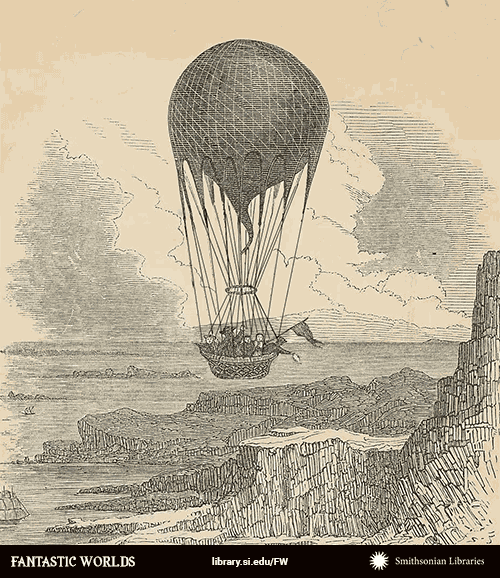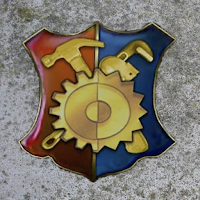As many of you know, the Aether Salon meets to discuss steam and Victorian topics on the third Sunday of each month, in Palisades and Academy, New Babbage. We have been doing so since October '08. This is our 25th salon and I hope you are all as excited about being here today as I am.
Just a few matters of housekeeping before we get started. If you are standing in the back, please move forward onto the maze so that you can be assured of hearing the speaker. Please hold your questions until the end, and as a courtesy to all, please turn off everything that feeds the lag: all HUDs, scripts, Pi shooters, AOs, and so on. Please no weapons, non-Euclidean geometry, inflammatory rhetoric, Time Machines, or bad ties. Your cooperation is appreciated.
Edited and unedited transcripts will be posted this week on aethersalon.blogspot.com so you can revisit today’s merriment, read transcripts of past salons, and for a laugh, peruse “overheard at the salon.” Please join the Aether Salon group and receive notifications of future salon events, click the lower right hand corner of the large brown sign by the entrance. We sincerely appreciate the support we receive from everyone in the community and we humbly thank you all.
Many fine people have contributed to today’s salon: We are grateful to Miss Canolli Capalini of Capalini Fine Furnishings for the wonderful salon chairs. We appreciate all of you who have contributed to salon. As a reminder, all speakers' fund jar donations go directly to the speaker. Now I will turn the stage over to Miss Sera for the introduction of today’s speaker.
Serafina Puchkina: Thank you! It is my great pleasure and privilege to introduce today's speaker.
Miss Bookworm Hienrichs first arrived in New Babbage nearly three years ago, after a year of desultory poking around in other, far-flung places of this world. She slowly began integrating herself into the community, despite her distinct lack of mechanical prowess, eventually becoming an event photographer for the monthly Piermont Landing balls and Aether Salons. She also joined the New Babbage militia, and is currently one of the liaisons for the Consulate of Europa Wulfenbach.
From an early age, Miss Hienrichs has had a very deep interest in the physical sciences--though she admits to being much less versed in the life sciences. She studied physics, chemistry, astronomy, and geology during her schooling, and still enjoys reading about the latest discoveries in these fields.
Please join me in welcoming Miss Bookworm Hienrichs.
Bookworm Hienrichs: In many areas of life, if you want to know where you're going, it's a good idea to know where you're starting from. This is certainly true in the realm of speculative fiction, including Steampunk. So if you want your ideas on the state of science in a Steampunk setting to be plausible, it's best to know what the state of science in Victorian times actually was, and then build realistically (so to speak) from there.
I should, I suppose, insert a disclaimer at this point. I've not actually read much speculative fiction, nor have I read anything from the Steampunk genre--at least, not yet. So I'm not sure how much authors in this area would agree with me. But it seems right to me, and, well, it gives me an excuse for this talk.
Also, as stated in my biography, I haven't much background in the life sciences, so this discussion will focus on the physical sciences. And we certainly cannot cover everything--that would probably be an entire year's worth of Salons. Instead, I'll hit a few highlights in the areas of physics, chemistry, astronomy, and geology.
One of the major developments in physics throughout the 19th century was in the area of electromagnetism. In 1820, Hans Oersted, a professor at Copenhagen University, was conducting electrical and magnetic demonstrations for some of his students. He noticed that when electrical current from a battery was switched on and off, a nearby compass needle was deflected from pointing toward magnetic north. This was the first indication to scientists that there is a link between electric and magnetic forces.
Soon afterwards, Michael Faraday began his pioneering work in electromagnetism. In 1821, he created the first demonstration of converting electrical energy into mechanical force by building a homopolar motor. This motor consisted of a free-hanging wire dipped in mercury, on which a magnet was placed. When a current was passed through the wire, a circular magnetic field was created around the wire, and the wire rotated around the magnet.
In 1831, Faraday discovered electromagnetic induction, by discovering that a moving magnetic field generates an electric field. Building on this, he soon discovered the property of mutual induction - a charge of current in one electric coil creates a current in another nearby coil.
Late in his career, Faraday developed the concept of field lines (he called them lines of force). This is a visualization of the actions of electromagnetic forces, and are used and taught today.
However, Faraday was not a mathematician. He made many discoveries in electromagnetism, but through experimentation and observation. He wasn't able to take the next step and explain these systematically. That was left to James Maxwell, who, in 1873, published a series of mathematical laws and equations that explained Faraday's discoveries and provided a complete description of the interactions among charges, currents, electric fields, and magnetic fields. (These equations were later simplified by Oliver Heaviside into four equations, now called Maxwell's Laws.) Maxwell had also, in 1864, determined that light consists of electromagnetic waves.
Now--ever wonder why Aether (or Ether) is such a prevalent word in our realm? Well, let me give you a bit of background. In Classical time (the Greeks, in other words), the aether was regarded as the pure essence the gods lived and breathed in. For the more scientific/philosophical Greeks, such as Plato and Aristotle, aether was the "fifth element." (No, not the cheesy Bruce Willis vehicle.) The other four elements--earth, air, fire, and water--had specific properties, and were subject to change. Aether, however, was the pure element; it had no qualities--heat, moisture, etc.--at all, and was incapable of change.
The concept of the ether (or aether) carried down through the years in various forms, and was used to explain various phenomena. By the 19th century, we have the Luminerferous Aether, which was viewed as a space-filling substance of field. It was believed to occupy every point in space, and acted as an absolute frame of reference for the universe. Once Maxwell showed that light was an electromagnetic wave, the aether was seen as the medium through which such waves could propagate. There seemed to be an easy--well, relatively easy--way to prove this. The motion of the aether past the Earth as the Earth orbited the Sun would create an "aether wind," which would affect the speed of light. Light would travel slower going "upwind" as it, in a sense, fought against that wind, and would travel faster going "downwind," as it added the speed of that wind to its own speed.
Throughout the 1880's, Albert Michelson and Edward Morley conducted a series of experiments using an interferometer, which could compare the time for light to reflect from mirrors in two directions. If the light was propagating through a luminiferous aether, there would be a change in phase of the light after it was split to head to the two mirrors. Can you all see the diagram? One light beam is split into two, and sent in two different directions, then reflected back to hit the same detector. Since the light beams are traveling in two different directions for a time, they should be traveling at *slightly* different speeds, and they'll be out of phase with each other when they reach the detector.

In 1887, Michelson and Morley published their results--one of the most important *negative* results ever obtained. They found that the speed of light was unchanged, no matter its direction. This was the first nail in the coffin for aether (or ether). This result also goes on to form part of the framework for a certain theory by one A. Einstein. (General Relativity - 1905).
The main developments in chemistry during the 19th century involve atomic theory and the periodic table. In 1808, John Dalton published an account of his atomic theory. Now, atoms themselves were nothing new--the ancient Greeks had first developed the idea of matter being made up of atoms, and had coined the term. Dalton, however, was the one to develop the idea of considering the relative weights and characteristics of atoms, and seeing how those fit together.
His theory, basically, stated that all matter is made of atoms, which cannot be divided or destroyed. (Well, *we* know they can, but not by chemical means, which was the only thing Dalton could consider at the time.) All atoms of a given element are identical in mass and properties. (Also not true, as we now know of isotopes.) Chemical compounds, he determined, are formed by the combination of two or more types of atoms. He also estimated atomic weights by the mass ratios in which they combined. However, his equipment was crude, so his estimates weren't very accurate.
Yes, lots of caveats and howevers in there. But at the time, this was rather revolutionary, and it laid the groundwork. Just three years later, one inaccurate aspect of Dalton's work, the atomic weight estimates, was improved by Lorenzo Romano Amadeo Carlo Avogadro di Quaregna e di Cerreto, Count of Quaregna and Cerreto. (*There's* a name for ya!) Avogadro discovered equal volumes of gases of any kind, if held at the same pressure and temperature, contain the same number of molecules. Differences in the masses of those gases, therefore, are related to their differing molecular weights. This discovery meant that one could gain more accurate measures of atomic sizes and weights.
Unfortunately, this discovery wasn't well known for nearly 50 years. This is partly because Avogadro was a rather private, retiring person. But it's also due to the fact that chemistry, as an organized science, wasn't that old at that point, and there were few opportunities to disseminate information.
As a result of this, not just news, but common conventions, such as nomenclature, symbology, and organization of elements, were slow to arise in chemistry at first. Hence the welcome given to Dmitri Mendeleyev (or Mendeleev) in 1869, when he first presented his periodic table of the elements.
Mendeleyev actually wasn't the first to try this. Just a few years earlier, an amateur English chemist named John Newlands had made the suggestion that a certain arrangement of the elements would show a repeating of properties. He arranged them in a pattern of eight, and actually called it the Law of Octaves. Not, perhaps, the wisest idea, as the idea was not only not accepted, but even mocked. (Wags in the audience at gatherings would ask him if he could get his elements to play them a tune.) Newlands eventually gave up on trying to get the idea accepted.
Mendeleyev used the same principle as John Newlands, but grouped the elements in patterns of seven. He listed the elements in rows in order of their atomic weight, and would start a new row when the chemical properties of the elements began to repeat earlier elements. His improvements over Newlands included leaving gaps on the chart for undiscovered elements, and, when necessary, ignoring the order suggested by atomic weight in order to better line up the chemical properties. (Later discoveries showed that he was ordering the elements by atomic number, which differs some from atomic weight, as it is based on the number of protons in the nucleus of the atom.)
In astronomy, a major development was in the area of spectroscopy. Spectroscopy is the process of studying the properties of an object by studying the light it emits. When a material is headed to incandescence, it emits light characteristic of the composition of that material. For instance, sodium, when it burns, emits a very characteristic yellow light. That material will also absorb light of the same wavelength, so if a light source is, in a sense, emitted behind a material, the spectrum of the light source will have dark lines that align with the properties of the material.
In 1816, Joseph von Fraunhofer, a glassmaker and manufacturer of optical instruments, invented a much improved spectroscope. When he used the spectroscope on the sun, he found hundreds of dark lines in the spectrum.
John Herschel, in 1823, was one of the first people to suggest that chemical analysis could be done by means of spectral analysis. However, he, and others, were hampered by the fact that they didn't realize that minute sodium impurities in their experiments were skewing their results. William Swan, in 1856, finally got the right amount of purity needed.
In the 1850's, Robert Bunsen and Gustav Kirchhoff conducted more detailed experiments, analyzing spectra of various elements. Kirchhoff then made a detailed study of the spectrum of the sun, comparing it to the elemental spectra. Based on this, he concluded that the outer layers of the sun must contain iron, calcium, magnesium, sodium, nickel, and chromium.
In 1864, William Huggins turned spectral analysis to other bodies in the sky. He discovered that nebulae and galaxies were different things entirely--nebulae have spectra of gases, while galaxies emit spectra of stars.
Then, in 1868, both Pierre-Jules Janssen and Joseph Norman Lockyer discovered absorption lines in the sun's spectrum of an entirely unknown element. This new element, called helium, wouldn't be discovered on Earth for 30 years!
Another important astronomical event in Victorian times was the discovery of Neptune, based on pure mathematical prediction. A Frenchman named Alexis Bouvard made detailed observations of the planet Uranus, and detailed discrepancies in its orbital path, compared to what Newtonian physics predicted. He hypothesized that there must be another planet beyond Uranus, which was affecting its orbit. In 1846, Urbain Jean Joseph Le Verrier spent months in complex calculations based on Bouvard's observations, and on August 31, announced to the French Academy his prediction of the position of this unknown planet. In September, he sent a letter about this to Johann Galle at the Berlin Observatory, and on September 23rd, Galle and Heinrich d'Arrest discovered Neptune within one degree of Le Verrier's predicted location.
Now, there's a rather interesting wrinkle in this. An Englishman named John Couch Adams was working on the same problem at the same time. However, he privately mailed his results to the Royal Greenwich Observatory two days *after* Le Verrier announced his prediction in France. Adams was also 12 degrees off in his prediction. But consider--if Charles Babbage had actually built his Difference Engine, and Adams had had access to such a device...Well, things might have turned out differently. (See what I mean about looking for plausible changes? *grin*)
In the field of geology--which I really couldn't skip--the story in the 19th century is more about debates over fundamental viewpoints rather than specific discoveries. The main debates were over the origin of rock strata--the look of the Earth--and over the age of the Earth.
In the late 18th century, one aspect of the debate over rock strata had developed--the Neptunists vs. the Plutonists. The Neptunists, with their main proponent Abraham Werner, believe that all of the rock layers of the Earth formed by the precipitation of material in a world-covering ocean. The Plutonists, led by James Hutton, believed the Earth and its rock layers formed through gradual cooling and solidification of molten masses.
A related argument that developed in the 19th century was catastrophism vs. uniformitarianism. Those who favored catastrophism said that the Earth's formation and history were a result of the accumulated effects of catastrophic events over a relatively short period of time. The key to uniformitarianism, which was popularized by Charles Lyell in the 1830's, is the phrase, "The present is the key to the past." Changes arise from slow-moving forces that are still at work today and can be studied, and the structure and appearance of the Earth today resulted from the steady accumulation of minute changes. A book by Lyell containing this theory was given to a certain young man who was setting out on a survey mission on the HMS Beagle. (More about that certain young man in a bit.)
Attempts to settle these arguments led to extensive work throughout the 19th century studying the stratigraphy--the layering--of rocks. Several scientists, for instance, used fossils to distinguish between rock layers, and tie rock layers together over distance. All of this work created the stratigraphic column, and relative dating of rocks and fossils.
Throughout the 18th and 19th centuries, attempts were made to determine the age of the Earth through scientific means. The Comte de Buffon, a natural scientist in the 18th century, studied the cooling rate of iron, and based on that, estimated the age of the Earth at 75,000 years. Hermann Ludwig Ferdinand von Helmholtz, one of the founders of thermodynamics in the 19th century, estimated the age of the sun (and therefore the Earth), based on luminosity and energy output from gravitational contraction, to be 20-40 million years. Lord Kelvin, in 1862, also studied cooling rates of materials, and came up with an estimate of about 100 million years, though he later revised that down to 20-40 million years.
None of this, though, satisfied the geologists who favored uniformitarianism. Their more observational theories led them to estimate that it would take at least hundreds of millions of years to create all of the rock strata seen in the Earth. This debate wouldn't be settled until the discovery of radiation, and the development of radiometric dating of rocks in the early 20th century.
Now, of course, this talk wouldn't be complete without at least touching on one particular scientist--Charles Darwin. He actually made his name, though, as a geologist and natural scientist long before publishing _On the Origin of Species._ When he went on the voyage of the Beagle, it was as a gentleman naturalist and companion to the captain, Robert FitzRoy. It was Captain FitzRoy who gave him a copy of the first volume of Charles Lyell's _Principles of Geology_, which had a profound effect on him.
Darwin conducted geological and natural history surveys during the voyage. He developed a theory on the formation of coral atolls that supported Lyell and uniformitarianism. He found a treasure trove of mammal fossils in Patagonia. He saw stepped plains of shingle and seashells as raised beaches, meaning the land had been elevated numerous times.
He did also observe biological specimens, including finches and tortoises in the Galapagos islands, and rheas in South America, and noted their differences. But Darwin wasn't as trained in biology or zoology, so these observations received somewhat shorter shrift. (He neglected, for instance, to note which finches and which tortoises came from which islands--he later had to rely of Captain FitzRoy's notes for that information.) When he returned from the voyage, he concentrated on other writings--the coral atolls, observations showing that the South American landmass was slowly rising, and classifying the barnacles he'd collected on the voyage.
A theory of evolution was coming to him in fits and starts, and he did work on it off and on, as other work, and health, permitted, but it wasn't until he learned that another naturalist, Alfred Wallace, had a draft paper outlining a similar theory that Darwin dusted off his notes and published the theory we all know so well.
Well! In this 50 minutes, I've managed to give you a quick introduction to just a small sample of Victorian scientific advances in the real world. Granted, the science of our world is more advanced in some cases--and downright mad, in other cases. But all of it, I think, still needs to be built on this basic framework. Move too far outside that framework, and the results become less and less plausible. One can, instead, know the framework, and then consider how that changes because of the event or events that create the Steampunk genre. I've given you one example of that, with the discovery of Neptune. A built and working Difference Engine would, conceivably, have sped calculations and results in a variety of discoveries in physics and astronomy. What other changes there might be--well, those I leave to you to figure out. And I look forward to reading about your discoveries.
Thank you.
Viv Trafalgar: Holocluck Henly has the first question, please go ahead Holocluck. (Darlingmonster, you're next)
Holocluck Henly: Thank you. Question: about this 19th century battery. when did we start to harness electricity this way which people could use for experiments?
Bookworm Hienrichs: Batteries were actually an older invention. The first one was the Leyden jar, in the mid-1700's, which "stored" static electricity.
Darlingmonster Ember: Were any discoveries of the 19th centure suppressed?? That would be interesting.
Bookworm Hienrichs: Suppression of discoveries? That I don't know about, Miss Ember.
Darlingmonster Ember: aha, so they were suppressed. Thank you
Bookworm Hienrichs: There is a very amusing anecdote about that, related to Darwin and evolution. Not quite suppression, but somewhat similar. A Scottish gardener named Patrick Matthew had come up with similar prinicples of natural selection the same year Darwin set out on the Beagle. Unfortunately, he published that work in the appendix of a book called 'Naval Timber and Arboriculture.' So it was missed not just by Darwin, but really the entire world. He made a fuss about it. In a letter to the 'Gardener's Chronicle.' Darwin did actually apologize.
Viv Trafalgar: Please give your warmest thanks to our fantastic speaker, Miss Book!
Linus Lacombe: Thank you for an enlightening presentation, Ms Book
Viv Trafalgar: There's a small token of our appreciation in front of the stage - scientific equipment for your laboratories, created by Mr. Jasper Kiergarten, who regrets not being able to be here. Please mark your calendars for next month's Salon! We'll be posting news about that very soon - it's very exciting! Thank you all so much for coming, and thank you Book for teaching us more about Science!
Solace Fairlady: A wonderfully delivered and very informative talk Miss Hienrichs, thank you so much!










